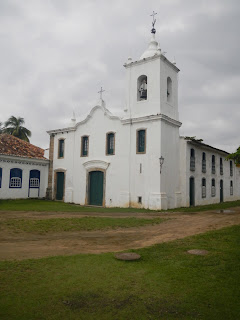Paraty
March 20, 2013
We
have arrived in Paraty. We landed at a
small runway right by the water and were met by out local guide Christian. Our
approach took us on a circle over the bay and gave us a grand opportunity to
see the wonderfully protected bay with the lots of beaches and islands. The Portuguese first came to Paraty in 1502
and they loved the harbor because it gave good shelter from pirates. They first
began to settle here in the late 16th century.. The first economic activity was sugar
cane. At first their relations with the
Indians were good. Then they started to
enslave Indians which of course led to contflict. . When gold
and diamonds were discovered in Minas Gerais around 1598 the port had a grand role to play. A road was build from Paraty to the mining
areas and it took over 40 days to make the trip. With the creation of the road to Rio, Paraty
went through and economic decline. With
the
a boom in tobacco and coffee production it enjoyed a resurgence. It suffered a second decline in the 1880s with the construction of the Rio to Santos (Sao Paulo) railroad which cut the road to Minas Gerais. It stayed a subsistence fishing village for 100 years. In 1965 there were only 400 people living in Paraty. Then in the 1980s a television soap opera was filmed here bringing notoriety to the area. That began the development of the tourist industry. It really does have terrific tourist assets with a beautifully protected harbor for pleasure craft, endless beaches and islands to explore and develop. It now has a population of about 35,000. A unique feature of the town is the way it is constructed to receive tides.
a boom in tobacco and coffee production it enjoyed a resurgence. It suffered a second decline in the 1880s with the construction of the Rio to Santos (Sao Paulo) railroad which cut the road to Minas Gerais. It stayed a subsistence fishing village for 100 years. In 1965 there were only 400 people living in Paraty. Then in the 1980s a television soap opera was filmed here bringing notoriety to the area. That began the development of the tourist industry. It really does have terrific tourist assets with a beautifully protected harbor for pleasure craft, endless beaches and islands to explore and develop. It now has a population of about 35,000. A unique feature of the town is the way it is constructed to receive tides.
At times
of high tides, the water of the bay washes into the town and flooding the
streets. When the water recedes it
cleans the streets. Here is a picture
taken from a post card.
Contrast it with
picture below of the streets as we walked around at low
tide.
After
a 10 minute drive we arrived at our hotel, Casa Turquesa. It is beautiful and more like a boat than a
building. It is painted in white and
turquoise with polished wood floors. Our
room is on the second floor and very comfortable. It was developed from an old commodity
warehouse and is on the waterfront. We
were greeted by TeTe, attractive peppy the owner. She explained that guests are requested not
to wear shoes in the hotel and a basket for one’s shoes is provided in the
lobby along with flip flops. Because in
the case of strong tides the streets flood, each room is also provided boots. We were given a little time to settle in and
to wait until 3 pm as it was deemed better to let the sun set a little to
modify the heat. It looks to me like it
will rain in the afternoon and hopefully cool things of.
At three we went out and explored the old village. No cars are allowed inside the old town. The streets are cobblestone and are slanted toward the middle to facilitate drainage when the tide recedes. No cars are permitted in the old city. The city is built on a mangrove swamp. When it was first settled, a village was built with a fort on top of one of the surrounding hills. However, soon that was not big enough so the village was moved to its present location in the 17th century. To build, first a stone square was built with the foundation outlines of the building. Then the square was filed in with dirt . Then a stone base was build on the dirt to serve as the foundation for the building In this way landfill was created one building at a time. Two rivers flowing to the bay, the Pereque-Acu and the Patitiba, border the area of the town. Here are couple of shots of the town:
The town has several churches, each dedicated and usd by the different classes of the local population, the Europeans, the slaves and the freed slaves. The roman Catholic had an agreement with the Portuguese crown. The Church would be given gound on which to build a church and when the church was completed taxes would have to be paid. These churches are all not quite finished and this incompleteness allowed the church to avoid taxes.




No comments:
Post a Comment